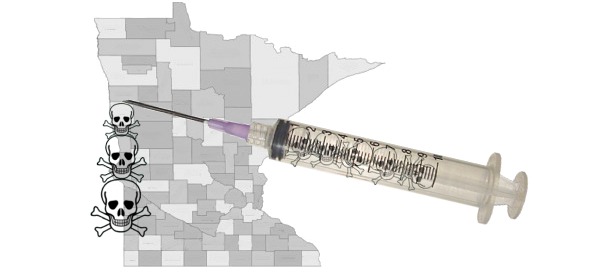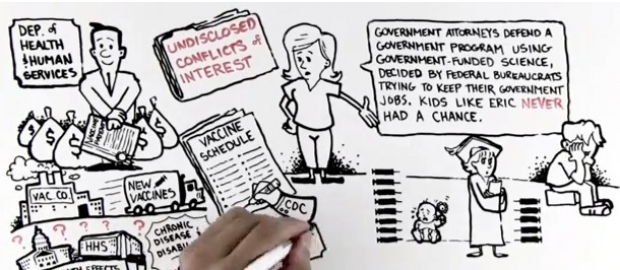Featured
Back & Knee Pain Sufferers: Beware a New Class of Drugs

Graphic by Nik van Es. You can see more of his work at http://www.flickr.com/photos/nikolasvanes/. (Clickable link at end of article.)
Suffering from back pain can be pure misery. It can be chronic, resulting in loss of career and many of life’s pleasures. Even so, how many of its sufferers would knowingly take a drug that may permanently worsen the condition and damage nerves?
The FDA has just decided that testing a group of drugs, called anti-Nerve Growth Factors (anti-NGFs), with precisely those outcomes can go ahead. Since most have already reached Phase 3 testing, the final testing before they’re pushed on the public, it shouldn’t be long before we start seeing the news media promoting them as the best thing since sliced bread for back pain.
Anti-Nerve Growth Factors
Nerve Growth Factors are proteins required for protection, repair, and growth of peripheral and central nervous system nerves. Neurons that don’t have an adequate supply of NGFs kill themselves through apoptosis.
Anti-NGF drugs are intended to counter the effects of NGFs, proteins that are necessary for nerve health. Just think about that for a moment:
If anti-NGF drugs work, then they must damage the nervous system. It shouldn’t be surprising to learn that Phase 2 short-term trials showed that these drugs result in—among other problems—headaches, abnormal sensations, such as tingling, itching, numbness, and hypersensitivity, and loss of deep tendon reflexes. These are, of course, clear signs of nerve damage—exactly what you’d expect to see in a drug whose purpose is to counter the effects of the proteins that protect, repair, and grow nerves.
These symptoms of nerve-damage were termed merely “minor”. So Phase 3 trials were started. And a surprising new risk reared its head.
The first of these trials resulted in sudden and dramatic worsening of the condition itself. Some patients developed osteonecrosis, also known as avascular necrosis, a very serious and debilitating condition of bone death resulting from loss of blood supply. All three clinical trials, by three different companies, were halted by the FDA. That was last year in 2010.
The FDA has just decided to allow the testing to start again.
The Benefit?
The reports up to this point tell a story of major improvements in low back pain from osteoarthritis. One of the principal investigators for Pfizer’s entry in the market, tanezumab, is Nancy E. Lane, Professor of Internal Medicine and Director of the University of California at Davis’ Center for Healthy Aging. According to Science Daily, she stated:
I believe that the apparent worsening of certain patients’ condition may be due to the fact that tanezumab works so well. People feel so much better that they become more active, putting increased stress on their already badly diseased joints.1
She makes it sound like there’s such a huge improvement in pain that the risk of bone death may not be such a big deal. So how much easing of pain does the drug provide? According to MedPage Today, it’s quite small. On an 11-point scale, in a 16 week trial, the drug’s improvement over placebo was:
Pain Improvement on an 11-Point Scale:2
Week 2: 0.7 points
Week 4: 1.1 points
Week 6: 1.4 points
Week 10: 0.9 points
Week 16: 0.5 points
The maximum improvement was just 1.4 on a scale of 11—a mere 12.7% improvement.
The study’s co-author claimed that a mere 12.7% improvement in pain was so great that subjects put enough stress on their joints they caused the bone to die! Exactly how they did that without exceeding their threshold for pain in the process isn’t explained, either.
With such minimal improvement in pain over placebo, even after all the tricks played in pharmaceutical drug testing and the very real and severe dangers uncovered in trials—some of which were easily predictable—the FDA is allowing tests to go forward.
Just whose side is the FDA on?
The Players
Some studies have shown that some pain conditions have an associated increase in NGFs. As is so common in modern medicine, the assumption is that the symptom is the disease, rather than considering that it may be the body’s attempt to heal a condition.
Naturally, Big Pharma’s immediate plan was to see if suppressing these presumed-excessive NGFs could ease pain. They went scrambling to capitalize on the idea. Pfizer produces tanezumab, Janssen produces fulranumab, and Regeneron produces REGN475. They’re being trialed for different varieties of chronic pain, including for cancer. However, the most active research is being done in osteoarthritis, which is common and responsible for most low back pain.
Now that the studies are on again, it shouldn’t be long before Big Pharma’s next great disaster gets its PR machine rolling on this “promising new class of pain drugs”. The media will jump on the bandwagon, giving the impression that people suffering from back, knee, cancer, and probably other types of pain can soon look forward to a wonderful new drug that will ease their misery. Of course, it’ll also be claimed that side effects were minimal, or words that that effect.
Patient groups will be mobilized to pressure the FDA to approve the anti-NGF drugs. There’ll be a clamor to ease the misery of these people. Drug companies will act as if they had nothing to do with creating that clamor. They’ll say that all they’re doing is trying to ease suffering.
In reality, Big Pharma is using their nearly-limitless coffers to manipulate the FDA, the scientists, the journals, the statisticians, the media, and even the patients themselves so they can profit from the misery of people in pain.
Sources:
- 1Tanezumab Reduces Osteoarthritis Knee Pain, Phase II Study Finds
- 2AAPM: Nerve Growth Factor Antibody May Reduce Pain
- FDA: Continue Study of Antinerve Growth Factors for Pain
- FDA Panel Gives the Green Light for More Anti-NGF Testing
- U.S. Probes Resuming Painkiller Trials Tied to Joint Failure
- More Favorable Results With Tanezumab for Various Pain Types
- Pfizer Immediately Halts Tanezumab Osteoarthritis Trials
- Efficacy and safety of tanezumab in the treatment of chronic low back pain.
- Preliminary assessment of the safety and efficacy of tanezumab in Japanese patients with moderate to severe osteoarthritis of the knee: a randomized, double-blind, dose-escalation, placebo-controlled study.
- Tanezumab for the treatment of pain from osteoarthritis of the knee.
- NGF
- http://www.thepharmaletter.com/file/100981/usas-fda-puts-stops-on-johnson-johnsons-fulranumab-and-regeneronsanofi-aventis-osteo-drug-due-to-side-effect-risks.html
Tagged anti-ngf testing, anti-ngf trials, back pain, back pain anti-ngf drugs, big pharma, big pharma anti-ngf, conventional medicine, evidence-based medicine, fda anti-ngf, junk science, knee pain anti-ngf drugs, modern medicine, pharmaceutical drugs, pharmaceuticals, pseudo-science, pseudoscience
Related Posts
-
avinash
-
John













